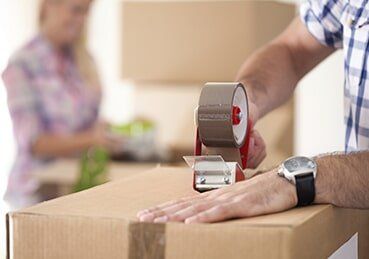Packing Tips
Make sure you pick up the right kind of boxes for your items.
A-1 Self Storage offers a number of different choices for your convenience. Talk with our facility personnel to determine the number and size of boxes you may need to make your move easier.
Step 1 – Packing Your Boxes
- Group your items together of comparable size and weight. Try not to combine belongings from different rooms of your home.
- Create a layer of crumpled packing paper into the bottom of the box. Place heaviest items in the bottom of the box once wrapped in packing paper. Pack small heavy items in small boxes so larger boxes do not become too heavy to pick up.
- Wrap additional, lighter items with packing paper and place the lighter items on top in the box.
- To prevent shifting and damage to your goods, cushion the entire package using crumpled packing paper stuffed firmly into unfilled spaces before closing your box. Your filled box should not weigh more than you can easily lift. Under packed boxes may collapse in transit, while over packed boxes can rupture, damaging belongings.
- Finally, label the box with its contents and destination room. Close the box and seal it with sturdy packing tape.

Step 2 – Loading the Truck
- Sort all the items you are moving into three categories: heavy, medium, and light. When loading items, remember to try and pile items as close to the ceiling of the moving van as their weight will allow. Load items onto the van moving from the wall closest to the cab (front) to the door of the van (back).
- Load the largest and heaviest items first such as appliances. Place the heaviest pieces in a row across the floor in the front (wall closest to the cab) of the moving van. Make sure heavier items are evenly distributed to balance the truck. Use pads to ensure items are protected properly.
- Long flat items such as mattress sets and mirrors should be placed along the walls of the moving van to keep them upright and save to space.
- Load largest and heaviest boxes first, placing these on top of the heaviest items in the front of the truck and on the empty floor. Place lighter boxes on top of the heavier boxes working your way from the front (wall closest to cab) of the van to the back (door) of the van.
- Ensure all cavities in the van are filled. Moving pads can be used or pillow, towels, sofa cushions, or bedding to fill empty spaces and protect your items. Any small light items can be used to fill any empty space.
- Load fragile/awkward shaped items last. Ensure these items are properly secured to limit damage during transport. In addition, secure any loose items to prevent shifting during transport.
- Transport medication and important documents with you at all times, not in the back of the moving van, in case of an emergency.
Storage Tips
- Make a plan for the organization of your storage unit. This will help you find items later when needed.
- Leave a walkway(s) in the unit to facilitate access to items in the back of the unit.
- Heavy items should go on the bottom with lighter items on top.
- Don't stack boxes higher than what is comfortable for you to access later.
- Leave some space at the sides of your storage unit for air flow.
- Place items in the front of the unit that you want to access more frequently.
- Always empty fluids before storing lawn and garden equipment or anything with a small engine.
- Never store perishables such as food. This can cause problems with rodents.
- Use protective covers on furniture and mattresses such as blankets and mattress covers.

10. Shelving can be used to maximize your storage space
11. Label all boxes clearly, legibly, and on all sides for easy identification later.
12. Label anything fragile that needs extra care such as mirrors and collectibles.
13. Utilize larger appliances like refrigerators for storing additional items such as bedding and towels.
14. Disassemble large furniture items to maximize space utilization. Tie items together to prevent loss, label what they belong to and store with the item from which they were disassembled.
15. Climate controlled storage should be used for any items that are temperature sensitive such as photos, videotapes, and wooden furniture.
16. Pack high value items in unlabeled boxes and place in the back of the storage unit.
17. Never store medication or important, irreplaceable documents.







